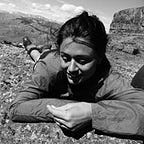Wildfire and Change
Returning and revisiting, 21 months later.
September 2014 — By afternoon, Yosemite’s once-clear sky is thick. The wisp of smoke that appeared at dawn has doubled each hour into a tornado-like column. Even from two valleys away, the smell of fire clings to our clothes, hair, lungs. Where the wind reaches, the landscape takes on a new color: surreal orange, the sun diminishing to an eery ringed dot.
The transformation is awful, in the word’s original meaning. I know theoretically that wildfire is a periodic natural occurrence here. And yet witnessing its early stages brings a kind of crazy energy. The force that sounds routine in a textbook feels historic and marvelous in front of my eyes.
We drive back west. I move into a new apartment, meet new classmates, and fill my days with new preoccupations. Distance opens up immediately between me and my former life: the dream job where I’d spent the past five years, those colleagues, that universe of concerns. During the first week at the GSB, I keep a tab open on my computer to follow the progress of the Meadow Fire. Wind-spread, the fire makes its way through the backcountry of Yosemite National Park as Week Zero unfolds.
June 2016 — I walked through that burned forest a few days before graduation, wandering around for a while before remembering that I watched the beginnings of this very fire 21 months ago.
Some might see ruin, but look closely and you’ll find bits of compelling beauty. Evening light softens the austerity of dead trunks, mostly upright but punctuated with toppled logs. Yellow-orange moss carpets damp areas. Ferns cluster around pools of water. Patches of clover dot the black ground.
Whatever the forest will become has only just started becoming. In five years, shrubs will crowd in, hip-high. Ten years out, small trees. But now, there are only hints of what is to come.
In this reflection-charged moment, I grasp for parallels. Despite puzzling over the meaning of this GSB experience, I’ve struggled to hold tangible conclusions. If I’ve already forgotten all of accounting, what traces of those “hard skills” I ostensibly came here to get will stick with me longer term? Did I really need T-group to tell me that avoiding eye contact is bad, and while hearing that felt like a revelation in the moment, did the feedback actually catalyze change?
Classmates accumulate lessons and professors attempt tidy take-aways. I question what I really feel for myself. Plenty of the phrases sound true enough — I’m all for authenticity and time management, I guess? — but I’m not sure those are the lessons I’d independently arrive at.
Some realizations came seemingly “too late.” I wish I’d researched second-year classes more, and considered which GSB classics I could use. I should have made more time to write. At least seven hours of sleep does make me happier. Showing up for an hour usually is more fun than not going.
Worse yet, those ones lead me to imagine hypothetically-possible realizations that now won’t come at all. Did I miss out on discovering some hidden talent? Which unmet-classmates could have been close friends?
So I find a moment of grace studying an altered landscape just beginning a long new path of change. Regrowth from fire comes layered onto other shifts: seasons alternate, bears and other animals make their inroads. Right now, wildfire looks like the defining event. With time, its force will come into line with the massiveness of Yosemite’s granite geology, the springtime floods of snowmelt, the pervasiveness of human visitors. The story of the place won’t reduce down to one factor.
What I will make of this experience, I’m realizing, will also evolve with time. Definitive judgment on the value of the GSB does not arrive with our diplomas. I can block three hours to “reflect,” and while I’ll enjoy picking through almost-forgotten moments, that time won’t lead to a conclusion that sticks. Instead, I imagine that two months or ten years from now, that thought will come to mind: Oh, NOW I understand.
This forest ecosystem requires flashes of upending change: the Sierra Nevada forests naturally experience fire (lightning-caused) every thirty or so years. For over a century, forest management called for extinguishing wildfires immediately. Fire seems reckless and dangerous; timber gets burned for nothing. Yet suppressing periodic fires alters the natural regime, allowing undergrowth to accumulate. When lightning does start a fire that can’t be put out right away, the resulting fire burns hotter and destroys more. Now, best practice suggests letting small natural fires burn themselves out, with the knowledge that this permissiveness fosters a greater order.
This understanding of episodic change resonates with me as well. Coming back to school shook up my life, but toward what end? Maybe it’s the question that’s the problem: “toward an end” misrepresents the shaping force of big moments of transition.
Looking back, my life has included plenty of episodes of throwing myself into the new, not just 21 months ago but also ten years ago and ten days ago. I use the phrase “when I’m a grown-up” implying a steady-state adult life, but can’t fully picture such a thing. Stasis, for too long at least, might not lead to satisfying stability.
Maybe it’s precisely those moments of creative destruction that keep us going. Periodic sweeps of fire through our lives look terrifying — especially when we can’t discern the consequences immediately. Yet perhaps I let change into my life less as a critique of what’s imperfect, more as a gesture of faith in shake-ups as part of a larger (if mysterious) order. In this moment, forest and fire offer an image I can hold onto of episodic transformation as a stabilizing force over a long time horizon.
